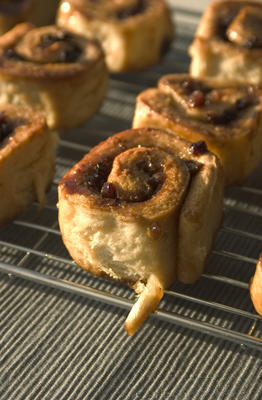
A divergence from my traditional British baking; but not too far astray... With thanks to Becks and Posh for hosting the event.
First rule of cooking vegan is to concentrate. I got home from work, turned the oven on in readiness for my cake, and then went to the fridge to get the eggs out to bring them to room temperature. EGGS. Eggs have clearly no place in vegan cakes, and if one slips in then the game is over. Fortunately whilst sieving the flour (innocuous) I looked over at the carton and realised my mistake. Daft thing is that the main reason I wanted to take part in this IMBB event was to see how a cake turns out without eggs. I've made dairy-free cakes in the past, but never omitted all animal ingredients. To me a cake should be stuffed full of lovely ingredients such as eggs, milk, butter - all nice natural products and if bought from the right sources not too unfriendly to animals (I hope). This is a test to see how good a cake can be if it doesn't include any of these 'key' ingredients, and to see if it passes muster with my tasting panel.
My recipe comes from Oxfam's website, and is to promote their Fair Trade merchandise - Vegan Fudge Cake.
Having regained my concentration, I was a bit perturbed when reading through the recipe method to see soya flour included in the list of dry ingredients to first put together. No mention of soya flour on the ingredient list. Don't PANIC. Blimey, looks like a lot of water to add to the dry ingredients; are you sure that this isn't going to be a chocolate soup? A quick consultation of a few recipe books later, and I decide that the proportions of self-raising flour to sugar to fat look OK. Decide to add the water half at a time, and if all goes soupy add a little more flour. Proceed with caution (easy on the vinegar - I think this reacts somehow with the baking powder - could be wrong). Phew, looks fine.
Into the tin and into the oven. I baked for 25 mins as the recipe suggests, and then a further 10 minutes with a tin foil 'hat' on (the cake, silly), to prevent charring. Cake was pretty damp still after 25 minutes, but had a good looking crust to the top.

The fudge topping was a doddle to mix up, but as I had made a loaf cake I only used half the quantity of ingredients compared to the recipe. You need to keep whisking the icing until it thickens sufficiently to apply to the top of the cake. The (soya)margarine content means that the fudge icing keeps a nice gloss even when it has cooled completely.

So what did my tasters think? As the dish was pretty obviously a chocolate cake, I asked the tasters if they could determine what was missing from the cake. They were a little bit suspicious, but to be fair I am not sure that you could have spotted the lack of milk, butter of eggs from the appearance or the taste of the cake. The sponge rose nice and high, and the consistency was light and fluffy, with a good moistness. I thought the sponge was a little lacking in favour and would have been more tasty with a bit more cocoa powder added (or melted chocolate). However as the fudgy icing was so rich, the lack of strong flavour in the cake was not really too much of a problem. All in all I was pretty impressed by my animal-free baking. Eating vegan is obviously a piece of cake...

I some post-baking research about the combination of baking powder and vinegar. Baking POWDER needs a liquid to make it active, where as baking SODA need an acid such as vinegar to get it going. Although baking powder does contain a small amount of baking soda (sodium bicarbonate), the water in the Vegan Fudge Cake recipe should have done the job of activation, so I am not convinced that the vinegar was really necessary. At least it didn't impart a fish'n'chip tang to the cake. Stephanie Jaworski explains the job of baking powder and soda so clearly on her Joy of Baking website, that it is best to read it for yourself if you are interested in learning more. Also, check out Bobby Thompson's site for more imaginative ideas for demonstrating the reaction between baking powder and water. I shall be buying a baking powder submarine directly.

IMBB # 19 + Vegan















